Dosing & Uses
Dosage Forms & Strengths
transdermal patch
- 7mg/day
- 14mg/day
- 21mg/day
Smoking Cessation
>10 cigarettes/day
- 21/14/7-mg regimen: 21-mg patch once daily for 6 weeks, then 14-mg patch once daily for 2 weeks, then 7-mg patch once daily for 2 weeks
≤10 cigarettes/day
- 14/7-mg regimen: 14-mg patch once daily for 6 weeks, then 7-mg patch once daily for 2 weeks
Administration
Apply to clean, dry, nonhairy area of skin (typically upper arm or shoulder)
Apply new patch upon awakening and wear patch for 24 hours, unless vivid dreams or insomnia occur (then remove patch before bedtime)
Do not cut patch
There are no significant safety concerns associated with using more than 1 over-the-counter (OTC) nicotine replacement therapy (NRT) simultaneously or at same time as another nicotine-containing product (including cigarettes)
Patients who use OTC NRT while trying to quit smoking but slip up and smoke should not stop using NRT but should keep trying to quit
NRT users should still pick "quit day" and begin using OTC NRT product on that day even if they are not immediately able to stop smoking
It is important for patients to complete the full program, but some may need to use NRT for longer periods to keep from smoking
Safety and efficacy not established
Adverse Effects
Frequency Not Defined
Acne
Anorexia
Arthralgia
Back pain
Bronchitis
Cough
Diarrhea
Dizziness
Dysmenorrhea
Dyspepsia
Headache
Hiccups
Increased blood pressure
Increased salivation
Indigestion
Insomnia
Irritability
Irritation at application site
Jaw or neck pain
Migraine
Nausea
Rhinitis
Sinusitis
Tachycardia
Taste disturbance
Tooth abrasions
Vomiting
Xerostomia
Postmarketing Reports
Dysphagia
Chest pain
Anaphylactic reaction
Seizure
Warnings
Contraindications
Hypersensitivity to drug or excipients
Cautions
Weigh risk versus benefits in patients with cardiovascular or peripheral vascular disease, including history of myocardial infarction, serious cardiac arrhythmia, or vasospastic diseases (eg, Prinzmetal angina, Raynaud phenomena)
Use caution in patients with oropharyngeal inflammation, peptic ulcer disease, or history of esophagitis
Use with caution in patients with insulin-dependent diabetes, pheochromocytoma, or hyperthyroidism
Extensively metabolized in liver; hepatic impairment may decrease clearance
Peptic ulcer formation and delayed wound healing associated with nicotine replacement therapies
Poisoning or fatality may occur in children if agent is inhaled, ingested, or buccally absorbed
Use caution in patients with angina, recent myocardial infarction, or hypertension
Before using consider the following
- Heart disease, recent heart attack, or irregular heartbeat; nicotine can increase heart rate
- High blood pressure not controlled with medication; nicotine can increase blood pressure
- An allergy to adhesive tape or have skin problems because you are more likely to get rashes
- Diabetes
- History of seizures
Stop use if the following occur
- Skin redness caused by the patch does not go away after four days, or if skin swells, or get a rash
- Irregular heartbeat or palpitations
- Experience symptoms of nicotine overdose such as nausea, vomiting, dizziness, weakness, and rapid heartbeat
- Symptoms of an allergic reaction (such as difficulty breathing or rash)
Pregnancy & Lactation
Pregnancy category: D; tobacco smoke is known to cause low birth weight, spontaneous abortion, increased perinatal mortality, decreased placental perfusion; however, nicotine replacement is believed to be safer during pregnancy than smoking
Lactation: Nicotine and metabolite (cotinine) pass into breast milk after maternal smoking; risk of exposing infant to 2nd-hand smoke may be more detrimental than that posed by NRT; nicotine may increase infant heart rate
Pregnant or breastfeeding patients should seek advice of healthcare professional before using OTC drugs
Pregnancy Categories
A: Generally acceptable. Controlled studies in pregnant women show no evidence of fetal risk.
B: May be acceptable. Either animal studies show no risk but human studies not available or animal studies showed minor risks and human studies done and showed no risk. C: Use with caution if benefits outweigh risks. Animal studies show risk and human studies not available or neither animal nor human studies done. D: Use in LIFE-THREATENING emergencies when no safer drug available. Positive evidence of human fetal risk. X: Do not use in pregnancy. Risks involved outweigh potential benefits. Safer alternatives exist. NA: Information not available.Pharmacology
Mechanism of Action
Systemically absorbed; binds to nicotine receptors; reduces withdrawal symptoms (including nicotine craving) associated with smoking cessation
Absorption
Absorption: 68%
Duration: 24 hr
Peak plasma time: 8-9 hr
Peak plasma concentration: 5-17 ng/mL (average)
Elimination
Half-life: 3-4 hr
Excretion: Urine
Images
| BRAND | FORM. | UNIT PRICE | PILL IMAGE |
|---|---|---|---|
| nicotine transdermal
-
|
21 mg/24 hr transdermal system | 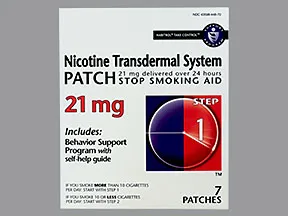 |
|
| nicotine transdermal
-
|
21 mg/24 hr transdermal system | 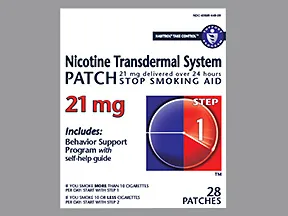 |
|
| nicotine transdermal
-
|
21 mg/24 hr transdermal system | 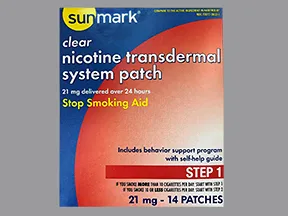 |
|
| nicotine transdermal
-
|
14 mg/24 hr transdermal system | 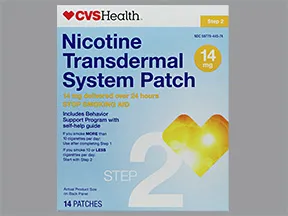 |
|
| nicotine transdermal
-
|
21-14-7 mg/24 hr transdermal system |  |
|
| nicotine transdermal
-
|
7 mg/24 hr transdermal system | 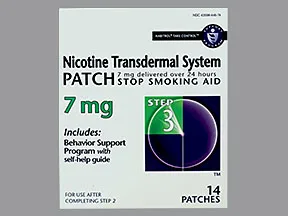 |
|
| nicotine transdermal
-
|
7 mg/24 hr transdermal system | 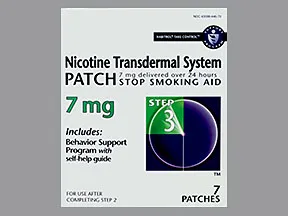 |
|
| nicotine transdermal
-
|
14 mg/24 hr transdermal system |  |
|
| nicotine transdermal
-
|
14 mg/24 hr transdermal system |  |
|
| nicotine transdermal
-
|
21 mg/24 hr transdermal system |  |
|
| nicotine transdermal
-
|
21 mg/24 hr transdermal system |  |
|
| nicotine transdermal
-
|
7 mg/24 hr transdermal system | 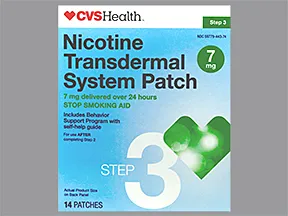 |
|
| nicotine transdermal
-
|
14 mg/24 hr transdermal system | 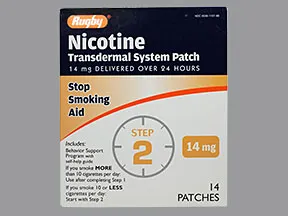 |
|
| nicotine transdermal
-
|
21 mg/24 hr transdermal system |  |
|
| nicotine transdermal
-
|
21 mg/24 hr transdermal system |  |
|
| nicotine transdermal
-
|
7 mg/24 hr transdermal system |  |
|
| nicotine transdermal
-
|
14 mg/24 hr transdermal system | 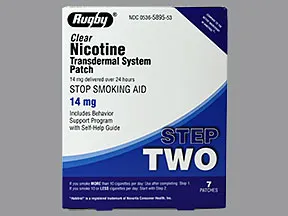 |
|
| nicotine transdermal
-
|
7 mg/24 hr transdermal system |  |
|
| nicotine transdermal
-
|
21 mg/24 hr transdermal system | 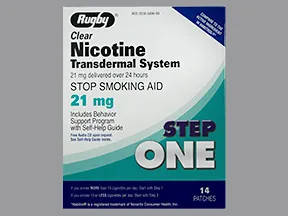 |
|
| nicotine transdermal
-
|
14 mg/24 hr transdermal system | 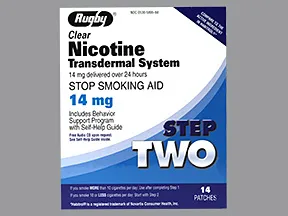 |
|
| nicotine transdermal
-
|
21 mg/24 hr transdermal system | 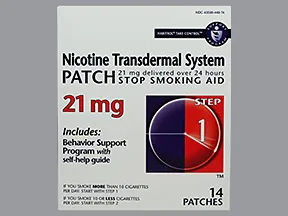 |
|
| nicotine transdermal
-
|
21 mg/24 hr transdermal system | 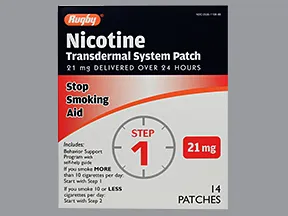 |
|
| nicotine transdermal
-
|
14 mg/24 hr transdermal system | 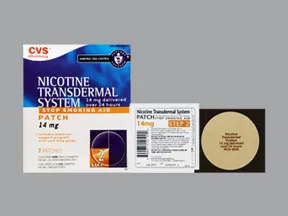 |
|
| nicotine transdermal
-
|
7 mg/24 hr transdermal system |  |
|
| nicotine transdermal
-
|
21 mg/24 hr transdermal system |  |
|
| nicotine transdermal
-
|
21 mg/24 hr transdermal system | 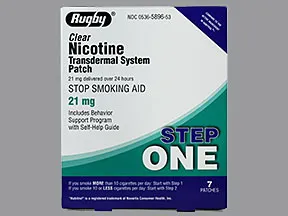 |
|
| Nicotrol NS nasal
-
|
10 mg/mL liquid | 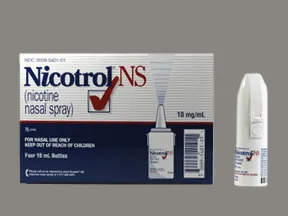 |
|
| Nicoderm CQ transdermal
-
|
21 mg/24 hr transdermal system | 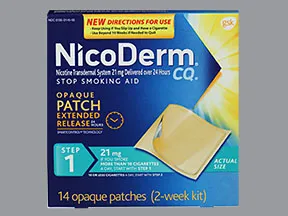 |
|
| Nicoderm CQ transdermal
-
|
7 mg/24 hr transdermal system | 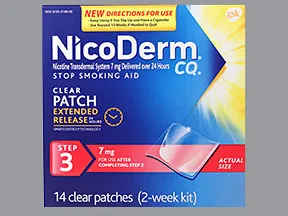 |
|
| Nicoderm CQ transdermal
-
|
7 mg/24 hr transdermal system |  |
|
| Nicoderm CQ transdermal
-
|
21 mg/24 hr transdermal system |  |
|
| Nicoderm CQ transdermal
-
|
14 mg/24 hr transdermal system | 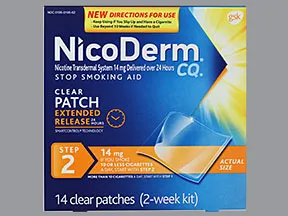 |
|
| Nicoderm CQ transdermal
-
|
21 mg/24 hr transdermal system | 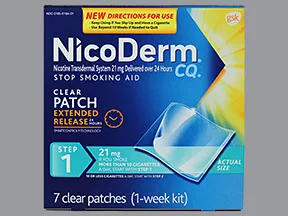 |
Copyright © 2010 First DataBank, Inc.
Patient Handout
nicotine transdermal
NICOTINE PATCH - TRANSDERMAL
(NICK-oh-teen)
COMMON BRAND NAME(S): Habitrol, Nicoderm CQ, Nicotrol
USES: This medication can help you quit smoking by replacing the nicotine in cigarettes. The nicotine in tobacco is an important part of cigarette addiction. When you stop smoking, your nicotine levels drop quickly. This drop can cause withdrawal symptoms such as craving tobacco, nervousness, irritability, headache, weight gain, and difficulty concentrating.Stopping smoking is hard and your chance of success is best when you are ready and have made a commitment to quit. Nicotine replacement products are part of a total stop-smoking program that includes behavior change, counseling, and support. Smoking causes lung disease, cancer, and heart disease. Stopping smoking is one of the most important things you can do to improve your health and live longer.
HOW TO USE: If you are using the over-the-counter product, read all directions on the product package before using this medication. If your doctor has prescribed this medication, read the Patient Information Leaflet if available from your pharmacist before you start using this product and each time you get a refill. Make sure you understand how to apply a new patch and dispose of the used product. If you have any questions, ask your doctor or pharmacist.Start this medication on your quit (smoking) day. The patch should be applied to a clean, dry, non-hairy area on the trunk or upper arm. Check the manufacturer's instruction sheet for recommended areas to place the patch. If necessary, clip hair from the site before applying the patch. Do not shave the area. Remove the patch from the package, peel off the protective strip, and immediately apply the patch to the skin. Press firmly for 10 to 20 seconds to make sure the patch stays in place. Be sure the edges are held firmly to the skin. Wash your hands with plain water after applying the patch. Do not use soap.The best dose for you is the dose that decreases the urge to smoke without side effects from too much nicotine. If your doctor has prescribed this medication, follow your doctor's orders carefully. Your dose will need to be adjusted to your needs, including smoking history and medical condition.Different brands of nicotine patches have different amounts of nicotine and different instructions for how long to leave the patch on the skin (such as for 24 hours or only while awake). Consult your doctor or pharmacist about which brand of patch to use. If you wake up craving cigarettes, the 24-hour patch may be best. If the patch causes vivid dreams or interferes with sleep, you may need to wear the patch only while awake (16 hours each day).Do not apply the patch to red/cut/irritated skin or over other skin products (such as makeup, lotions, powders). Do not use the patch if the individual pouch is open or damaged or if the patch is cut, torn, or damaged. Apply the patch to a different area on your body each time to avoid irritation. Wait at least a week before using the same application site. Apply a new patch if your patch falls off.Do not wear a patch for more than 24 hours. Do not wear more than 1 patch at a time. After removing each patch, fold it in half so it sticks to itself, and discard in the trash away from children and pets.Use a new patch each day, applying it at the same time each day to help you remember, usually when you wake up. After several weeks, you will gradually lower your dose (strength of patch) until you no longer need nicotine replacement. It is important to complete the treatment with this medication (8 to 10 weeks). If after the treatment period, you still feel the need to use this medication to prevent you from smoking, talk to your doctor.If you suddenly stop using this medication, you may have withdrawal symptoms (such as tobacco cravings, nervousness, irritability, headache). To help prevent withdrawal, your doctor may lower your dose slowly. Withdrawal is more likely if you have used nicotine for a long time or in high doses. Tell your doctor or pharmacist right away if you have withdrawal.Tell your doctor if you have not been able to quit smoking after using this product for 4 weeks. Some smokers are unsuccessful the first time they try to quit. You may need to stop using this product and try again later. Many people who cannot quit the first time are successful the next time.
SIDE EFFECTS: Mild itching, redness, burning, and stinging at the application site may occur. Stop using this product and tell your doctor if redness caused by the patch does not go away after 4 days. Nausea, dizziness, flushing, heartburn, or headache may also occur. Common nicotine withdrawal symptoms can occur when you stop smoking and include dizziness, anxiety, depression, or trouble sleeping, among others. If any of these withdrawal symptoms or side effects last or get worse, tell your doctor or pharmacist promptly.If your doctor has directed you to use this medication, remember that your doctor has judged that the benefit to you is greater than the risk of side effects. Many people using this medication do not have serious side effects. Serious side effects are more likely if you continue to smoke while using this product.Stop using this medication and tell your doctor right away if you have any serious side effects, including: mental/mood changes (such as irritability, trouble sleeping, vivid dreams), numbness/tingling in hands/feet, swelling hands/ankles/feet.Stop using this medication and get medical help right away if you have any very serious side effects, including: chest pain, confusion, severe headache, fast/irregular/pounding heartbeat, trouble speaking, weakness on one side of the body.A very serious allergic reaction to this drug is rare. However, get medical help right away if you notice any symptoms of a serious allergic reaction, including: rash, itching/swelling (especially of the face/tongue/throat), severe dizziness, trouble breathing.This is not a complete list of possible side effects. If you notice other effects not listed above, contact your doctor or pharmacist.In the US -Call your doctor for medical advice about side effects. You may report side effects to FDA at 1-800-FDA-1088 or at www.fda.gov/medwatch.In Canada - Call your doctor for medical advice about side effects. You may report side effects to Health Canada at 1-866-234-2345.
PRECAUTIONS: Before using this product, tell your doctor or pharmacist if you are allergic to nicotine; or to adhesive tape; or if you have any other allergies. This product may contain inactive ingredients, which can cause allergic reactions or other problems. Talk to your pharmacist for more details.Before using this medication, tell your doctor or pharmacist your medical history, especially of: blood vessel disease (such as Raynaud's disease, stroke), diabetes, heart disease (such as chest pain, heart attack, irregular heartbeat), high blood pressure, liver disease, kidney disease, esophagus problems (such as esophagitis), stomach/intestinal sores (peptic ulcers), certain adrenal problem (pheochromocytoma), overactive thyroid (hyperthyroidism), seizures, skin problems (such as eczema, contact dermatitis).Before having surgery, tell your doctor or dentist about all the products you use (including prescription drugs, nonprescription drugs, and herbal products).If you are going to have an MRI test, tell testing personnel that you are using this patch. Some patches may contain metals that can cause serious burns during an MRI. Ask your doctor whether you will need to remove your patch before the test and apply a new patch afterward, and how to do so properly.Strenuous exercise may raise your skin temperature and increase the amount of nicotine absorbed through the skin. Talk with your doctor about the effects of exercise on this medication.Avoid exposing the skin under the patch to direct heat sources such as heating pads, electric blankets, heat lamps, saunas, hot tubs, heated water beds, or prolonged direct sunlight while wearing your patch. Heat sources may cause more drug to be released into your body, increasing the chance of side effects.Nicotine and smoking may harm an unborn baby. If you are pregnant, try to stop smoking without using a nicotine replacement product if possible. During pregnancy, this medication should be used only when clearly needed. Discuss the risks and benefits with your doctor.Nicotine from smoking and from this medication passes into breast milk and could have undesirable effects on a nursing infant. Smoking near an infant can also harm the infant. Consult your doctor before breastfeeding.
DRUG INTERACTIONS: Drug interactions may change how your medications work or increase your risk for serious side effects. This document does not contain all possible drug interactions. Keep a list of all the products you use (including prescription/nonprescription drugs and herbal products) and share it with your doctor and pharmacist. Do not start, stop, or change the dosage of any medicines without your doctor's approval.Stopping smoking can change the way the liver removes certain drugs from the body (including acetaminophen, caffeine, insulin, oxazepam, pentazocine, propoxyphene, propranolol, theophylline, tricyclic antidepressants such as amitriptyline/imipramine, "water pills"/diuretics such as furosemide). Tell all your doctors and pharmacists that you are quitting smoking.
OVERDOSE: This medication patch may be harmful if chewed or swallowed. If someone has overdosed, remove the patch if possible. For serious symptoms such as passing out or trouble breathing, call 911. Otherwise, call a poison control center right away. US residents can call 1-800-222-1222. Canada residents can call 1-844-764-7669. Symptoms of overdose may include: confusion, drooling, seizure, slow/shallow breathing, hearing problems.
NOTES: If your doctor has prescribed this medication for you, do not share it with others.
MISSED DOSE: If you forget to change your patch on time, change it as soon as you remember. You can change your next patch 24 hours later or go back to your usual dosing schedule. Do not double the dose to catch up.
STORAGE: Store in original packaging at room temperature away from light and moisture. Do not store in the bathroom. Keep patches in the sealed protective pouch until ready to use. Apply patch immediately after removing from pouch. Do not use if the pouch is damaged, cut, or opened ahead of time. Keep all medications away from children and pets.Do not flush medications down the toilet or pour them into a drain unless instructed to do so. Properly discard this product when it is expired or no longer needed (See How to Use section).
Information last revised May 2024. Copyright(c) 2024 First Databank, Inc.
IMPORTANT: HOW TO USE THIS INFORMATION: This is a summary and does NOT have all possible information about this product. This information does not assure that this product is safe, effective, or appropriate for you. This information is not individual medical advice and does not substitute for the advice of your health care professional. Always ask your health care professional for complete information about this product and your specific health needs.







